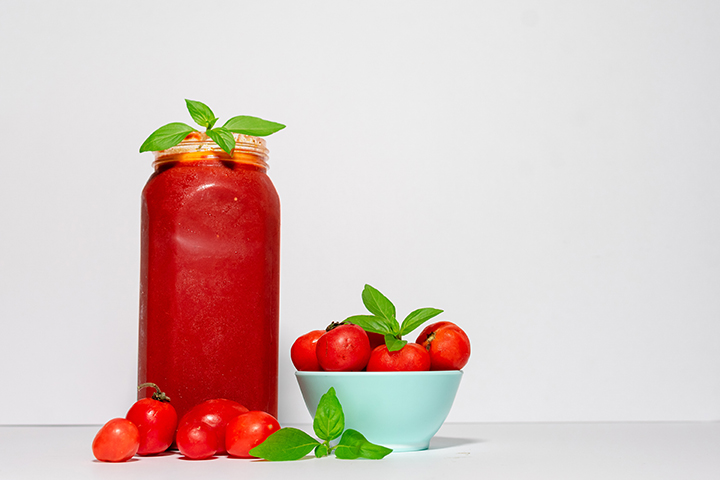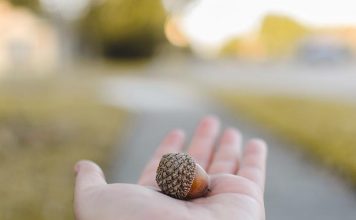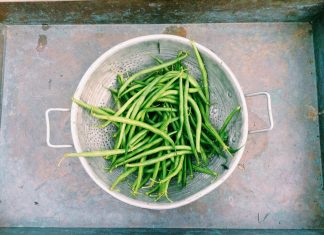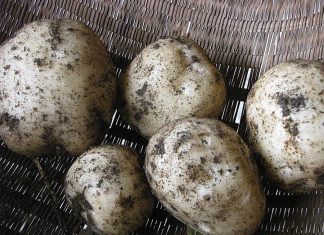 |
|
| Issue #52 • July/August, 1998 |
One of my earliest and fondest childhood memories is of my mother and me walking nearly a mile down the road from our house, in the rain, to deliver a fresh baked batch of Hamentaschen (pronounced hamen-tashin) cookies. We were taking them to a Jamaican family that had just moved into our neighborhood. It was in the early spring, and the gastronomically festive Jewish holiday of Purim (pronounced poor-EEM) was being celebrated in many of our neighbors’ homes. It happened that another one of my mother’s close friends had just given her the recipe for Hamentaschen and my mom could not wait to make a batch. A new family moving into the neighborhood was a perfect reason for sharing her new recipe. Despite never having eaten a pastry like Hamentaschen before, the gift was well received by our new neighbors and enjoyed especially by me and their two kids.
Hamentaschen
Hamentaschen is only one of many delicious desserts associated with Purim, the festival that celebrates the deliverance of the Jews from a massacre in the Persian Empire. The dessert is named for Haman, the malicious chief minister to the King of Persia, who devised the failed plot to kill all of the Jews. He wore a three pointed hat, hence the symbolic three pointed cookie. Unfortunately, this is a holiday that is little noticed by many today. But in the neighborhood where I grew up it was a big deal, and it’s carnival spirit affected everyone regardless of faith. For my mother, Purim, like Christmas and Easter, was a prime opportunity to jump into the kitchen and work with a host of new foods that were shared with her by her many friends in our neighborhood.
This recipe contains a formula for making the traditional poppy seed filling, from scratch. If you find yourself short of time, a 12-ounce can of Solo brand poppy seed filling, or prune filling, are good substitutes. For the best results, both the dough and the filling should rest in the refrigerator overnight before preparing the cookies for baking.
Hamentaschen |
|
Cookie dough:2 cups all purpose flour 2 tsp. baking powder 1/3 cup sugar ½ lb. margarine 2 Tbsp. honey 2 eggs grated rind of one orange ½ cup finely ground pecans 2 Tbsp. Lairds Applejack or brandy
|
Filling:1 cup poppy seeds 4 Tbsp. raisins ¾ cup apple juice 3 Tbsp. honey 4 Tbsp. sugar 1 Tbsp. grated lemon rind 1½ Tbsp. margarine 1 Tbsp. Lairds Applejack or brandy 1/3 cup finely ground pecans
|
Method (for the cookie dough):1. Combine the flour, baking powder and sugar in a large bowl. Stir with a wire whisk to blend the ingredients. 2. Using a pastry blender or two knives, cut the margarine into the flour until the mixture resembles course oatmeal. 3. In a separate bowl blend the honey, eggs, grated orange rind, ground pecans and Applejack. Gently stir this mixture into the flour. Continue stirring only until all of the ingredients are incorporated. 4. Shape the dough into a ball, dust it lightly with flower, wrap it loosely in waxed paper and place it in a gallon size ziplock plastic bag. Refrigerate the dough for at least six hours.
|
Method (for the filling):1. In a heavy bottom sauce pan combine the poppy seeds, raisins, and apple juice. Simmer the mixture over low heat until the seeds start to soften and the mixture starts to thicken, about 10 minutes. 2. Add the honey, sugar, grated lemon rind, margarine, and applejack. Continue to simmer the mixture for another five minutes. Remove the pan from the heat, stir in the ground pecans and set the mixture aside to cool. When cool, place the filling in an air tight container and refrigerate along with the dough.
|
Assembling and baking the cookies:1. Preheat the oven to 350 degrees F. 2. Remove the dough and the filling from the refrigerator and let both set at room temperature for 30 minutes. To make rolling the dough easier, divide it into two equal-size pieces. 3. On a lightly floured surface, gently roll the first half of the dough to a thickness of approximately 1/8-inch. Using a 3-inch cookie cutter, cut as many circles as you can, about 18. 4. Place one rounded teaspoon of filling in the center of each cookie. Form trianglar pyramids with each cookie by folding the edges of the dough up on three sides of the circle. Gently shape the raised edges up over the filling to form a pocket. Pinch the points of the newly formed pyramid to prevent the sides from falling during baking. 5. Place the cookies on a lightly greased baking sheet and bake until lightly browned, about 15 minutes.
|
|
Pickled chili peppers
My mom used pickled chili peppers as a basic flavor enhancing ingredient in countless recipes. In Boston during the ’50s and ’60s chili peppers were considered ethnic foods and were not as widely available in supermarkets as they are today. To an enterprising opportunist like my mother, this never seemed to pose any problem. She knew a great deal about chili peppers and knew how, when, and where to find the peppers she needed to prepare her assorted chili pepper dishes.
In New England, late August is prime season for home gardeners to harvest their chili pepper crops. Amy and John Wheatly, our Jamaican neighbors, maintained a huge garden, in which they grew three varieties of chili peppers: jalapeno, cherry, and a small blistering hot variety similar to the chiltepin of Mexico and the West Indian datil. Every August, my mother was invited into the Wheatly’s garden. She would pick several pounds of collard greens, bring them home, and cook them in her own special way. She would then exchange the whole batch of greens with Mrs. Wheatly for two gallons of freshly picked red chili peppers, mostly jalapeno and hot cherry. Then she would pickle the peppers and use them throughout the year to make her favorite chili pepper dishes.
In the old recipe file she kept I found recipes for several homemade table sauces made with chili peppers. My mom used these to add zip to just about every food she ate. Some of the sauces were aromatic and mild. Others were so fiery hot they were shared only with friends who shared my mom’s love of hot and spicy foods. “I’m afraid if I serve this stuff to anyone else, they’d probably end up walking around the room backwards,” was her usual comment after preparing a fresh bottle of her favorite hot sauce. Try the following pickled pepper recipe. But if hot peppers are not to your liking, substitute sweet cherry, pepperoncini, tomato, or any other ripe sweet pepper. The result will be a pickled sweet pepper with much of its natural flavor preserved in a gentile tasting sauce that is unlike most other acidy pickling solutions.
This recipe makes 8 to 12 pints, depending on the size of the peppers and how tightly you pack them. I use a mixture of jalapenos that are about 3-inches long and 1½-inches wide, along with cherry peppers that are about 1-inch long and 1½-inches wide and I don’t try to jam the peppers tightly into the jars. For me, this process yields 12 pints. You can count on getting at least eight.
Pickled chili peppers |
||
Ingredients: |
||
Brine:2 lbs. (1 gallon) fresh, ripe, chili peppers 1 gallon water 2 cups of sea or Kosher salt
|
Marinade:1 cup water 5 cups white vinegar (5% acidity) 2 Tbsp. sugar 1 tsp. dried thyme 10 whole allspice 1 tsp. whole coriander seeds 12 black peppercorns 12 white peppercorns 1 tsp. whole mustard seeds 2 juniper berries 6 whole cloves
|
Herb Oil Garnish:4 dried bay leaves 12 whole, unpeeled, garlic cloves (par boiled for 2 minutes) 2 carrots, par boiled for 2 minutes and sliced into 1/8-inch coins 6 peeled shallots 12 Tbsp. virgin olive oil
|
Method:1. Wash the peppers, trim the stems to a stub and prick each pepper twice with a fork on opposite sides. 2. Bring the water to a boil, immediately remove it from the heat, and dissolve the salt in it to make a brine. Let it cool. 3. Combine the washed peppers and the cooled brine in a glass, plastic, stainless steel, or other non reactive container. Place a china plate on top of the peppers to hold them down in the brine. Use two if necessary. Soak the peppers in the brine for a minimum of 12 hours. 4. Combine all the marinade ingredients in a heavy bottom stainless steel sauce pan. Bring this mixture to a boil, then reduce the heat to low and simmer, uncovered, for 10 minutes 5. Wash and sterilize 8 to 12 pint-size canning jars and lids. In each sanitized, hot jar place ¼ of a dried bay leaf, one garlic clove, several carrot slices, ½ of a shallot and 1 tablespoon of olive oil, then pack the peppers into the jars. Pour marinading liquid into each jar leaving at least ½-inch of head space from the top of the liquid to the rim. 6. Use a boiling water bath method to seal the jars and process the peppers for five minutes. Store the jars in a cool, dark place for three to four weeks before using. Refrigerate unused portions after you’ve opened a jar.
|
||
Nana V’s fire sauce
This is one of the many hot table sauces my mother made using her store of pickled peppers. It’s good on greens, eggs, and practically everything else. When I was a kid, at any given time one could find at least three different homemade hot sauces in our refrigerator. The uneducated palate would usually be hard pressed to distinguish one from the other but this sauce was the only exception, simply because it was always labeled as “sauce for greens.” In years when the late summer was hot and yielded little or no rain in Boston, chili peppers of all varieties would come off the bush as hot and flavorful as it was possible for each variety to get. Sauce for greens was made exclusively from these peppers, and was seldom offered to anyone outside my mothers small conclave of chili pepper lovers. Of course it is not necessary to use fire breathing chili peppers to assemble this recipe. The mixture of ripe jalapeno and cherry peppers that I suggested in the pickled pepper recipe will almost always give this sauce the right balance of heat and flavor. Unlike my mother, I don’t limit the use of this sauce to cooked greens. I use it as an all purpose sauce to add zip to any food, including my over easy eggs at breakfast.
Nana V’s fire sauce |
Ingredients:1 pint homemade pickled chili peppers from the previous recipe 1 12 oz. bottle chili sauce ½ cup pickling marinade strained from the chili peppers ½ cup Lairds Applejack or brandy 1 Tbsp. Worcestershire sauce ¼ tsp. fresh ground black pepper ¼ tsp. ground coriander 1/8 tsp. liquid smoke 1/8 tsp. ground cumin
|
|
Method: 1. Strain the peppers saving the pickling liquid, garlic clove, shallot, and carrot slices. Discard the spices. 2. Remove the stems and seeds from each of the peppers, and process the peppers, garlic clove, shallot and carrot slices into a paste, using a food processor or blender. 3. Combine the chili pepper paste, chili sauce, pickling liquid, applejack and Worcestershire sauce in a stainless steel sauce pan. Simmer the mixture over low heat for five minutes. Stir in the black pepper and coriander and simmer for another minute. 4. Remove the sauce from the heat and stir in the liquid smoke and cumin. 5. Let the sauce cool in refrigerator. You may prefer a thinner sauce, so before bottling, adjust the thickness of the sauce to suit your preference by adding a little more pickling liquid or applejack. Store in the refrigerator in a sanitized pint canning jar or other sanitized container of your choice.
|
Mystery salsa
I will be honest here and admit that I don’t know where my mother got this recipe. I have included it in this collection because she uses a measured amount of her pickled peppers, as a flavor enhancer. For her to limit a measured amount of any enhancer in a recipe meant that she was creating a formula for some special purpose. I can only guess that she found a basic fresh salsa recipe that she liked and customized it to suit her own taste.
I first served this sauce to some close friends at a surprise birthday party for Tricia, my wife. The adults gobbled the first batch so fast that I had to make a second batch for the kids and myself. This sauce is easy to make and can be prepared year round because it uses canned plum tomatoes. Unlike salsas made from fresh tomatoes, it will keep in the refrigerator for a couple of days without loosing its zip.
Why canned tomatoes? My mother was a cook who understood that the so called fresh tomatoes sold in New England during the winter were immature fruits that were picked green in some unknown part of the world then shipped to our area, placed in gas chambers, and treated with ethylene gas to turn them red. The science of using this simple hydrocarbon gas to ripen immature fruit has been around since the 4th century B.C. But the result is lower nutrient value, bland taste, and a rubbery texture that is characteristic to all fruits treated in this manner. This unfortunate condition, however, is not a result of the ethylene treatment. Picking the fruit before it has a chance to mature naturally is the problem. Ethylene is produced naturally by fruit bearing plants well in advance of ripening and it initiates the ripening process in an organized and efficient way.
The good news is that most canned tomatoes are allowed to ripen on the plant, as nature intended, and the canning process does minimal damage to their taste and nutritional value. This makes them a much better choice for cooking during the off season. When fresh tomatoes are in season, simply substitute three cups of peeled, seeded and diced, very ripe fresh tomatoes for the canned tomatoes.
Try this salsa on eggs, hamburgers, hot dogs, or even as a dip for oysters and clams. I think that you will discover, as I have, that salsa can be enjoyed with more than corn chips.
Ingredients:1 28 oz. can name brand whole plum tomatoes (avoid bargain brands)
½ cup red onions
1/3 cup red bell pepper, finely diced
2 or 3 home pickled jalapeno or cherry peppers, finely diced
2 Tbsp. Lairds Applejack or brandy
¼ cup fresh cilantro, washed, drained and finely chopped
½ tsp. malt vinegar
kosher salt to taste
fresh lime juice to taste
Mystery salsa |
Method:1. Strain the tomatoes over a bowl and save the juice. Gently remove as many of the seeds from each tomato as possible without mashing the flesh. With a very sharp knife, dice the drained tomatoes into medium chunks. 2. Pour the juice into a heavy bottom, stainless steel sauce pan and simmer over low heat until it is reduced by half. Combine the reduced tomato juice with the diced tomatoes in a stainless steel or glass bowl. 3. Combine the red onion, bell pepper, pickled peppers, applejack, cilantro and malt vinegar. Add this mixture to the tomatoes, and let the salsa mellow at room temperature for a couple of hours. 4. After the mellowing period, taste the salsa and add salt and lime juice to suit your taste. This salsa is best when served the day it is made, but it will hold in the refrigerator for a couple of days with only a slight loss of flavor.
|
Raspberry ketchup
My mother was never a great ketchup lover but she frequently made table sauces that she called “flavored ketchup.” These sauces were usually prepared during Thanksgiving and Christmas holidays, packed into an assortment of fancy bottles, then given to friends and neighbors as gifts. She made these ketchup-like sauces from a variety of fruits combined with fresh or canned tomato sauce and spices. I chose this recipe because it is easy to prepare and my children love it. My in-house food committee, chaired by daughter Sarah with my two sons Jason and Michael holding the other two seats, gave this recipe a unanimous thumbs up. I have reduced my mother’s recipe from a 12-pint yield to about a pint because the larger quantity requires processing. Also, the fruits that are used to make these flavored ketchups are available all year long in fresh or frozen state and the finished sauce lasts for weeks in the refrigerator. My daughter Sarah says, “Tell everyone to try this ketchup with chicken, it’s great.”
Ingredients:1½ cups fresh or frozen raspberries
1 to 3 home pickled chili peppers (let your taste be the judge) or substitute 1/8 tsp. of cayenne pepper
1/3 cup fresh or canned tomato puree
1/3 cup wine vinegar
¼ cup medium or dry sherry
2/3 cup firmly packed light brown sugar
¼ tsp. ground clove
¼ tsp. ground ginger
½ tsp. fresh ground nutmeg
¼ tsp. kosher salt
1 Tbsp. butter or margarine
If you are using fresh raspberries, carefully pick them over and use only firm unblemished berries. If you are using the home pickled chili peppers, remove the seeds and the stems.
Raspberry ketchup |
Method:1. In a stainless steel heavy bottomed sauce pot, combine the raspberries and pickled chili peppers with the tomato puree, wine vinegar, and sherry. If you are substituting cayenne pepper for the peppers, do not add it at this time. Over low heat simmer the mixture for 60 seconds. 2. Over a bowl put the mixture through a food mill or press the mixture through a stainless steel strainer and discard the pulp. 3. Return the strained mixture to the stainless steel sauce pan along with the sugar, ground clove, ground ginger, ground nutmeg, salt, butter, and, if you are substituting it for the pickled peppers, cayenne pepper. Return the pot to the stove and simmer for about 10 minutes over a low heat until the desired consistency is reached. If the sauce appears to be too thick adjust the consistency with a little more vinegar mixed half-and-half with water. 4. Transfer the sauce to a sanitized pint canning jar, and place it in the refrigerator to cool. This sauce is at its best when warmed over low heat to just below the simmering point.
|
That’s it for this issue. I hope you enjoy the recipes and I know my mom would love the idea of sharing all of this good food with so many good people.














